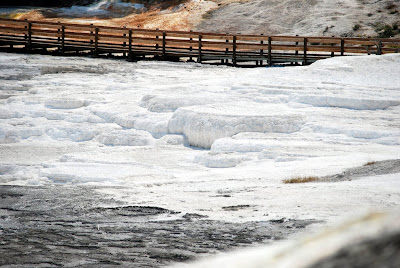We took the 1/3 mile trail to the paintpots. Then, there was a boardwalk that climbed above in order to get a overview of the area. You can kind of see the artist's palette down below.
As we walked over the boardwalk, we also saw numerous noisy paintpots bubbling and churning. These are acidic hot springs with a limited water supply. Some microorganisms use hydrogen sulfide as an energy source and convert the gas into sulfuric acid which then breaks down rock into clay. We spent a lot of time watching them.
Our next stop was the Norris Geyser Basin. We stopped at the Norris Museum which was built in 1930. We looked at the displays showing Yellowstone's history and hydrothermal areas.
Loop trails divide the area into two parts, Back Basin and Porcelain Basin. We started off around the larger area, Back Basin, stopping to see Steamboat Geyser. It can become the world's largest geyser, sometimes reaching 380 feet, but the eruptions are erratic. However, there are many small eruptions and we watched some of those.
We walked higher getting a good overview of the basin. Water in the springs here is generally both hotter and more acidic than the other geyser basins here. There are springs of different colors and sizes.
The blue pools of water are beautiful!
After spending a couple of hours at Norris, we headed north towards Mammoth Springs.
We passed fields, forests, and these beautiful rock formations.
We arrived at Mammoth Hot Springs and walked along the boardwalk looking at the giant terraces.
The north entrance to Yellowstone used to be the only entrance used by tourists in the very early years. Fort Yellowstone was also located here, as well as the headquarters for the CCC projects during the 1930's.
I took this picture of the post office which was built in 1936.
We hadn't planned on going as far as we went today, but it just seems once you get going in Yellowstone, you just can't make yourself stop. There are so many different things to see.














No comments:
Post a Comment